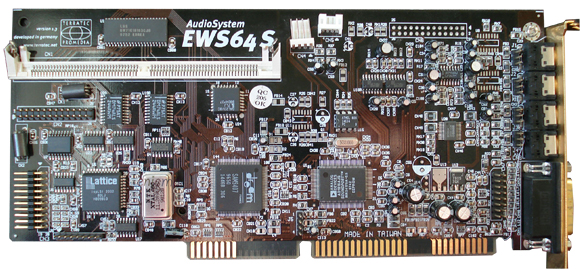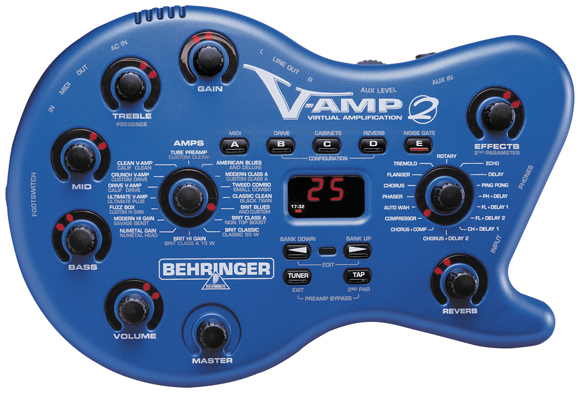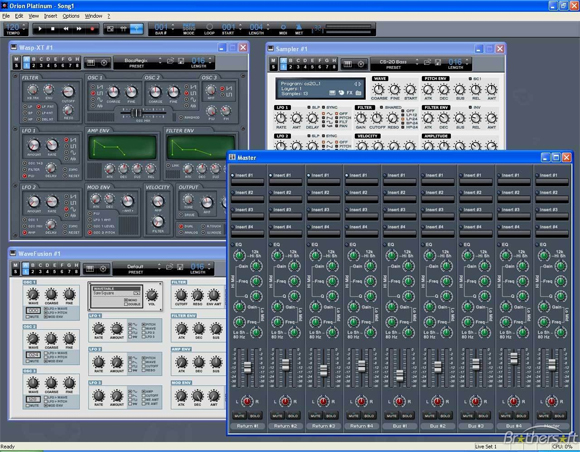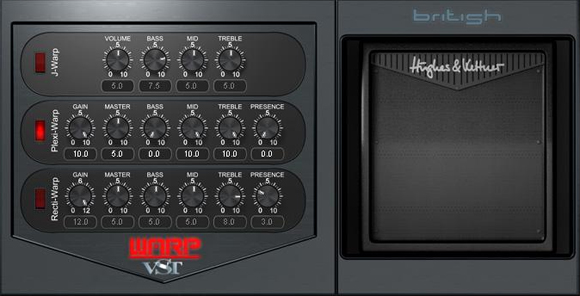|
|
|
|
harddisco early hardware
harddisco current hardware - pre-harddisco hardware- - - - - - - - sixth album - - - - - - - - |
||
| although i was
enjoying my pc based setup i still had my eye on stuff in future music.
i remember seeing an advert for terratec's ews64xl card, much more
powerful than my turtle beach maui for sample playback, and much better
recording than my original £20 consumer card (an ess 1868 if i remember
rightly). also, it came with this amazing sample editing software. edison, below, was so exciting, i had never seen anything like it and i wanted it sooo badly. sadly the ews64xl it came with cost £400, well out of my budget for a single item (about £150). |
i kept the advert for the ews64xl for ages, reading it over and over
again, and eventually they released a budget version, the ews64s, which
used the same amazing edison sample playback software. it was £129. the 64s had 2MB RAM onboard. eventually i got a 16MB simm from someone (part of a matched pair where one stopped working) so i had 18MB, an amazing increase. the recording quality was so much better as well, and my tracks reflected this. |
|
 |
 |
|
| with the late 90s analog revival,
i started craving something raw and raspy, with knobs. there was only one synth in my budget. i loved the raw oscillator of this synth (FAT freebass 383). the filter input was great too, i used to put drums and my bass guitar through it while controlling the envelope via MIDI. sound example: noisome (1:15 for filtered bass) |
i had been using the input on the
sw60xg card, which allowed me to process sounds with the onboard fx, but
it was very noisy. i wanted better quality fx, and a longer chain, more
processors. this digitech studio quad v2 was a quality processor, with 4 simultaneous fx available. it gave a richer quality to the sound, especially with the better recording quality from the ews64s. sound example: random metabolic reversion |
|
 |
 |
|
| i still wasn't writing any lyrics
at this point, but i did end up with 10 tracks (with a couple of repeats
due to better quality equipment) - this collection was called 'retroactive' - my sixth album and first harddisco album. |
||
| - - - - - - - - seventh - eighth albums (harddisco #2-3) - - - - - - - - | |
| i was
finally starting to write lyrics again, but having difficulty recording
them. i was still putting most sounds through the zoom 1010 and the
studio quad, and sampling these as loops. because i only had one output
from the soundcard (i had a soundblaster live by this point which was
pci and hence future proof). i couldn't process the vocals i recorded without having the vocal fx on the backing as well, and if i tried to fx the vocals by themselves i couldn't tell if it went with the track. eventually i just kept churning out instrumentals. the only extra bits of equipment i got were a waldorf pluse plus and a behringer dualfex enhancer. |
|
 |
 |
| the pulse plus came from a friend, he bought it and did a few tracks with it which were interesting. some of these ended up as collaborations on my albums. eventually he had to sell the pulse due to a road tax fine and i paid in installments. this had such a fat sound and magnificant filter, also with filter input which i loved feeding things into. sound example: infiltration | i bought the enhancer just to boost the final mixes up a bit, used along with the compressor from the studio quad. we got a bit of airplay on a local late night radio show, so we felt we needed to do something about the quality and loudness of the final mixes. we gave them a six track cd of instrumentals to play, which was well received apparently. |
|
between 99 - 2001 i ended up with two albums of instrumental tracks,
(completed as 'punishment' & 'end
product', both by harddisco, a few years later). i was really pleased with what i had achieved, but i was also getting excited with the possibilities of vsts. |
|
|
- - - - - - - - ninth album (harddisco #4) - - - - - - - - |
|
|
while working on end product tracks i started to use some early virtual
synths. i used a standalone version of ts404 which had a sequencer ,
then recorded the loops from it and imported them into my sequencing
software, which at the time was cubasis av - this was a freebie with my
terratec ews64s soundcard. it had 8 audio tracks and 32 MIDI tracks, but
no vst capability. later, i progressed from ts404 to using a demo
version of orion basic, which i connected to cubasis using a virtual
MIDI driver. for the ninth album i wanted to use vsts properly, so i bought a copy of cubasis vst 4 (£60). i used this for a short while, but i soon compared it with the demo of orion basic and found it inferior. cubasis could only load 4 vsts and had 1 insert per channel, orion had no limit on vsts and 2 inserts per channel and actually cost less ($59). i bought orion basic and started using it exclusively. initially i used a combination of free synths and fx, but eventually i sold the pulse plus and bought a copy of NI's dynamo, a collection of reaktor synths available just for instrument use, no editing available. i also bought a behringer v-amp2 for my guitar, so i wasn't abandoning hardware completely yet. |
|
 |
 |
|
the v-amp2 had a much more authentic sound than my old zoom 1010. 32 different amp tones and better fx. it didn't get much use during this album though, which ended up being entirely synth based. |
dynamo made a massive difference to how i worked. it had plenty of
synths and drum machines, percussion synths which i loved and still use
occasionally. the above vst is dsq32, a drum machine that i still use.
dynamo had only one effect, geekfx, an absolutely crazy combination of
filter, distortion, and delay modules which feed into each other and
even feed back into themselves. i still use this one today too, there's nothing else like it. |
|
now i had a vst daw and a suite of instruments, i needed to ugrade my
soundcard. the old creative soundblaster live had very high latency, so i ended up getting myself a creative audigy player (about £70) |
|
 |
|
| the
audigy player made a big difference due to asio drivers. i connected it
to my yamaha cbx-k1 controller keyboard, shown right. i actually had this keyboard since about 2000 but forgot to include it earlier. |
|
|
despite having the versatility and power of dynamo now available, i
entered a slow period, from 2002 to 2004, where i wrote about 4
semi-complete instrumental tracks using virtual instruments, with doubts
about the quality. i also wrote about the same number of songs using
guitars and bass along with the synths and drum machines. in 2005 i upgraded orion basic to orion pro ($39), a major new feature being audio tracks. i realised i could finally record the vocals from the 'punishment' album, and process the vocal tracks with vst effects. it was hard work but very fulfilling, as this was the first full vocal tracks album since 1995 (the value of suffering: 'ugly industry'). i finished it during 2005. sound example: social vortex during 2006 i turned my attention back to 'end product'. up to this point, all my instrumental tracks basically sounded like songs with no vocals, the arrangements were the same. the song might have 2 or 3 or even 4 sections, and i would simply repeat these to make the song - see retroactive for an album full of examples! i decided to give the 'end product' tracks more lasting interest by cutting out the repetition. to keep the tracks up to a reasonable length, i added extra synth and percussion parts, mostly from dynamo, and ended up with three sections in each track, with variations, and no repeating everything. this made for a more viable instrumental format, i thought. 'end product' as it is now was finished in 2006. sound example: project one inspired by this new method of building instrumental tracks, i went back to my more recent vst only tracks, and applied the same method. i reworked the 4 existing tracks and wrote 4 more, so 'reaction' (ninth album, 4th harddisco album) was also completed in 2006. this was my first album made entirely with virtual synths, also my first with no guitars whatsoever. sound example: reaction |
|
|
- - - - - - - - tenth album (harddisco #5) - - - - - - - - |
|
| as i
mentioned, while writing the first few songs that became 'reaction'
(from 2004), i wrote a few in my more traditional style, fusing
electronics and guitars. i was working on these during 2005 - 2006
amidst the revival of 'punishment' and 'end product,' and the completion
of 'reaction.' in 2007 'blatant superior'
was complete. it included one song (sound example:
universe) which
should have been included on 'punishment',
but i couldn't sort out the vocals for the verses. it also included one (in charge) written back in the days of 'retroactive,' in the previous century. i started to use real drum sounds, with the freeware nskit7 being my only natural drum sound source for this album. i also began to use virtual guitar processing, using steinberg's warp vst. by this point i was just using my v-amp 2 as a preamp to record a dry guitar sound, then processing in warp. also, i upgraded to orion platinum, the fully featured version 7.0 |
|
 |
 |
| the best new feature was the
master mixer, and the 4 buses. once i was mixing 4 channels of drums, and sticking them through the bus to be compressed together, i was wondering how i managed before. |
warp was one of the earliest amp sim programs, retailing for £150 when it came out. i got it for £15 a few years later, pretty chuffed about that. it has three amps, clean, crunch, drive, i tended to use the drive amp to cover my bad playing. i used it until windows 7 came out, as it was easier to get an 'indie' heavy guitar sound out of it than some of the newer amp sims. |
| this
pretty much concludes it for the hardware i used for my first 10 albums.
i went through a period of using software almost entirely, my only hardware being controllers and interfaces, etc. all my hardware except my behringer mx802 was sold to buy software instruments and fx. in recent years, however, i missed the tactile contact with synths and fx units, and started to buy some again. i even rebought many of the items that i had sold in the early 2000s. see here for details: harddisco current hardware |
|